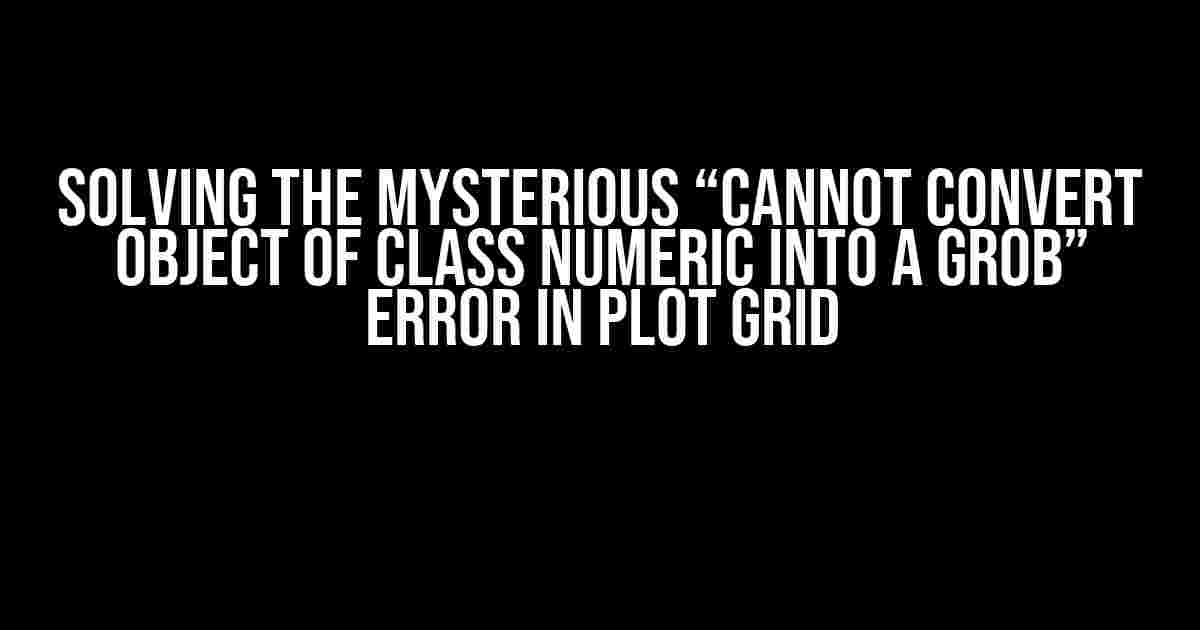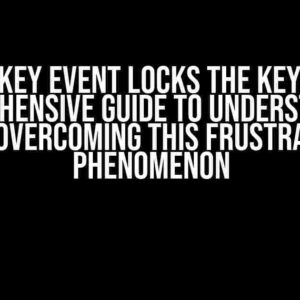If you’re reading this article, chances are you’ve encountered the frustrating error message “Cannot convert object of class numeric into a grob” while trying to create a stunning plot grid using the ggplot2 package in R. Don’t worry, you’re not alone! This error can be particularly pesky, especially when you’re convinced that all your objects are of class “gg”. But fear not, dear reader, for we’re about to embark on a journey to conquer this error and get your plot grid up and running in no time!
- What is a Grob, Anyway?
- The Error: “Cannot Convert Object of Class Numeric into a Grob”
- Solution 1: Check Your ggplot Objects
- Solution 2: Avoid Passing Numeric Objects to ggplot Functions
- Solution 3: Use the right Combination of ggplot Functions
- Solution 4: Use a List of ggplot Objects
- Troubleshooting Tips
- Conclusion
- Resources
What is a Grob, Anyway?
Before we dive into the solution, let’s take a step back and understand what a “grob” is. In the world of ggplot2, a grob (short for “graphical object”) is a fundamental building block of a plot. It’s an object that contains the visual elements of a plot, such as points, lines, polygons, and text. Think of grobs as the LEGO bricks that are used to construct your beautiful plot.
The Error: “Cannot Convert Object of Class Numeric into a Grob”
So, what happens when R throws this error at you? Essentially, it’s telling you that it can’t convert a numeric object into a grob. But why would it try to do that in the first place? The answer lies in the way you’re constructing your plot grid.
When you create a plot grid using ggplot2, you’re typically working with ggplot objects, which are of class “gg” or “ggplot”. However, if you accidentally pass a numeric object to a function that expects a ggplot object, R will throw this error. It’s like trying to fit a square peg into a round hole – it just won’t work!
Solution 1: Check Your ggplot Objects
The first step in solving this error is to verify that all your objects are indeed of class “gg”. You can do this using the class() function in R. For example:
library(ggplot2)
p1 <- ggplot(mtcars, aes(x = mpg, y = cyl)) +
geom_point()
class(p1) # [1] "gg" "ggplot"
p2 <- 5
class(p2) # [1] "numeric"
In the above example, p1 is a valid ggplot object, while p2 is a numeric object. Make sure to check the class of each object you’re working with to ensure they’re all “gg” or “ggplot”.
Solution 2: Avoid Passing Numeric Objects to ggplot Functions
The next step is to review your code and identify where you might be passing a numeric object to a ggplot function. A common mistake is to accidentally pass a numeric value to the grid.arrange() function from the gridExtra package. For example:
library(gridExtra)
p1 <- ggplot(mtcars, aes(x = mpg, y = cyl)) +
geom_point()
p2 <- 5
grid.arrange(p1, p2) # Error: Cannot convert object of class numeric into a grob
In this example, p2 is a numeric object, which causes the error. To fix this, ensure that you only pass ggplot objects to the grid.arrange() function.
Solution 3: Use the right Combination of ggplot Functions
Another common mistake is to use the wrong combination of ggplot functions. For instance, you might try to use grid.arrange() with a single ggplot object, like this:
library(gridExtra)
p <- ggplot(mtcars, aes(x = mpg, y = cyl)) +
geom_point()
grid.arrange(p) # Error: Cannot convert object of class numeric into a grob
In this case, you should use the plot_grid() function from the cowplot package instead:
library(cowplot)
p <- ggplot(mtcars, aes(x = mpg, y = cyl)) +
geom_point()
plot_grid(p) # Correct!
Solution 4: Use a List of ggplot Objects
If you need to arrange multiple plots in a grid, make sure to pass a list of ggplot objects to the grid.arrange() function. For example:
library(gridExtra)
p1 <- ggplot(mtcars, aes(x = mpg, y = cyl)) +
geom_point()
p2 <- ggplot(mtcars, aes(x = disp, y = qsec)) +
geom_point()
p3 <- ggplot(mtcars, aes(x = hp, y = drat)) +
geom_point()
grid.arrange(list(p1, p2, p3)) # Correct!
By passing a list of ggplot objects, you ensure that each element is correctly converted into a grob, avoiding the “Cannot convert object of class numeric into a grob” error.
Troubleshooting Tips
If you’re still struggling with this error, here are some additional troubleshooting tips to help you identify the issue:
- Check the class of each object you’re working with using the
class()function. - Verify that you’re using the correct ggplot functions and combinations of functions.
- Ensure that you’re passing a list of ggplot objects to the
grid.arrange()function. - Review your code for any accidental assignments or modifications that might be causing the error.
Conclusion
The “Cannot convert object of class numeric into a grob” error in plot grid can be frustrating, but it’s often a simple mistake that can be easily fixed. By following the solutions outlined in this article, you should be able to identify and resolve the issue, getting your plot grid up and running in no time. Remember to check your ggplot objects, avoid passing numeric objects to ggplot functions, use the right combination of functions, and use a list of ggplot objects when arranging multiple plots in a grid. Happy plotting!
| Solution | Description |
|---|---|
| Check ggplot objects | Verify that all objects are of class “gg” or “ggplot” using the class() function. |
| Avoid passing numeric objects | Ensure that you’re not passing numeric objects to ggplot functions, especially grid.arrange(). |
| Use the right function combination | Use the correct combination of ggplot functions, such as plot_grid() from the cowplot package. |
| Use a list of ggplot objects | Pass a list of ggplot objects to the grid.arrange() function when arranging multiple plots in a grid. |
By following these solutions and troubleshooting tips, you’ll be well on your way to creating stunning plot grids with ggplot2. Happy plotting!
Resources
If you’re new to ggplot2 or need more resources to help you master plot grids, check out the following resources:
- The ggplot2 documentation: https://ggplot2.tidyverse.org/
- The gridExtra package documentation: https://cran.r-project.org/web/packages/gridExtra/gridExtra.pdf
- The cowplot package documentation: https://cran.r-project.org/web/packages/cowplot/cowplot.pdf
Frequently Asked Question
Got stuck with the pesky “Cannot convert object of class numeric into a grob” error in your plot grid? Worry not, friend! We’ve got you covered with some frequently asked questions and answers to get you back on track.
Q1: I’ve checked my objects, and they’re all class “gg”. Why am I still getting this error?
A1: Ah, but have you checked the objects within your ggplot objects? Sometimes, a numeric value can sneak its way into the mix, causing this error. Double-check your data and aesthetics to ensure they’re all properly formatted.
Q2: I’m using a custom theme, could that be the issue?
A2: You bet your plot grid it could! Custom themes can sometimes introduce unexpected numeric values. Try reverting to a default theme or stripping down your custom theme to identify the problematic element.
Q3: I’m trying to plot a complex dataset. Could the error be related to data size or complexity?
A3: While it’s unlikely that data size or complexity is the direct cause, it could be contributing to the error. Try breaking down your dataset into smaller chunks or using data aggregation to simplify your plot.
Q4: Are there any known issues or updates that could be causing this error?
A4: Yes, occasionally, package updates or conflicts can cause this error. Make sure you’re running the latest versions of ggplot2 and related packages. If the issue persists, try reinstalling or seeking help from the R community forums.
Q5: I’ve tried everything, and I’m still stuck! What’s my next step?
A5: Don’t worry, friend! If you’ve exhausted all troubleshooting options, it’s time to seek help from the R community or a data visualization expert. Share your code and data, and we’ll do our best to help you identify the issue and find a solution.



![Solved: “Pull Access Denied” Error for Docker Packages in [Region] Solved: “Pull Access Denied” Error for Docker Packages in [Region]](https://larson.hkhazo.biz.id/wp-content/uploads/sites/554/2024/07/solved-pull-access-denied-error-for-docker-packages-in-region-with-text-300x300.jpg)